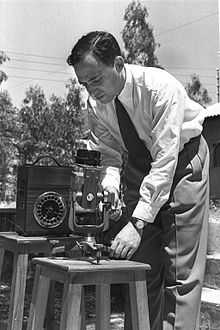Harry Zvi Tabor

Harry Zvi Tabor (born March 7, 1917 London, England)[1] is an Israeli physicist. He is known as the father of Israeli solar energy.[2][3] He is generally credited with having brought Israel's solar energy program to international prominence.[4]
Biography
Harry Zvi Tabor was born in 1917 to Charles and Rebecca Tabor. In 1947 he married Vivenne Landau. He received his bachelor's degree in physics from the University of London and Hebrew University.[5]
Scientific career
In 1949 prime minister David Ben-Gurion sent a letter to England to offer Tabor a job on the 'physics and engineering desk' of the Research Council of Israel, which he accepted. His first task was to create the National Physical Laboratory of Israel, which had been Tabor's idea as he felt it was essential the new country have the equivalent of the English National Physical Laboratory to create standards amongst the different measurements in use in the country, primarily British, Ottoman and metric.[3] Once the laboratory was established, he focused on solar energy for research and development.
He was instrumental in developing the solar water heater that 95 percent of Israeli households have.[3] In 1992 he was awarded an honorary degree from the Weizmann Institute of Science.[6] These simple water heaters operated without pumps, whereby cold water was heated in the panel, which acted as a thermosiphon. This unit in turn became the standard for solar water heating world wide, and helped popularize the commercialization of solar thermal technology in the United States in the 1970s, where Tabor lectured and acted as a consultant to solar start-up companies such as Northrup, Inc. which subsequently merged into ARCO Solar, which became BP Solar. Tabor experimented with various coatings to optimize the absorptivity of solar energy, with minimizing the re-radiation, or emissivity of the heat absorbed. This led to his development of a "black chrome" surface for the copper water-bearing plate.
Tabor worked with the Standards Institute of Israel, to establish testing procedures and an official performance certificates so that a solar collector could not be bought without SII certification.
Tabor and French immigrant Lucien Bronicki developed a small solar power unit, the Organic Rankine cycle turbine, for developing countries with problematic power grids.[4][7] It was designed to neutralize the maintenance issues of reciprocating engines so it had only one moving part, the rotor. A 3 kWe prototype was exhibited at the 1961 United Nations Conference on New Sources of Energy in Rome, but it failed to find commercial success.[7]
Awards and recognition
- 1975 - Royal Society Energy Award
- 1981 - International Solar Energy Society Award
- 1981 - Krupp Foundation Energy Award
- 1994 - Passive Low Energy Architecture International Award
- 1995 - Israeli Knesset Quality of Life Award
See also
References
- ↑ The Environment Encyclopedia and Directory 2001. Europa Publications Limited. 2001. p. 543. ISBN 1857430891.
- ↑ BGU shields its eyes and stares into the solar future, Ehud Zion Waldoks, The Jerusalem Post, November 2, 2008.
- ↑ 3.0 3.1 3.2 Bright ideas, Ehud Zion Waldoks, Jerusalem Post, October 1, 2008.
- ↑ 4.0 4.1 Harry Zvi Tabor, Cleveland Cutler, Encyclopedia of the Earth, 2007.
- ↑ Harry Zvi Tabor, The Environment Encyclopedia and Directory 2001, by Europa Publications Limited, 3rd Ed, Europa Publications, Europa Publications.
- ↑ Honorary degrees of the Weizmann.
- ↑ 7.0 7.1 Israeli Section of the International Solar Energy Society, edited by Gershon Grossman, Faculty of Mechanical Energy, Techion, Haifa; Final draft.
|